Sustainable Coating Additives: Transforming the Landscape of the Paint Industry

The term, “sustainable paint,” was first used in the coatings business decades ago. However, the majority of today’s corporate activities routinely take sustainability into account on a daily basis. Beyond lowering volatile organic compounds (VOCs), the focus has greatly expanded to encompass energy and resource conservation, waste reduction, process efficiency improvement, the use of renewable resources, and much more.
The paint additives sector has made significant strides. The fundamental goal of modern formulations is to include new beneficial elements that can offer functional, aesthetic, and environmental advantages. There are a few ways that paint companies are becoming sustainable, such as using recycled materials in their paint and using fewer toxic ingredients in paint.
At present, the industry utilizes a wide range of coating additives, and leading manufacturers are constantly investing in research activities to expand their existing portfolios. Enabling enhancements such as preventing growth of mildew, quick drying paints, and superior adhesion, to name a few, are a focus of many manufacturers.
Numerous companies are focusing on improving the antibacterial properties and the smell of coating additives. As the demand for other enhanced characteristics such as UV protection, dispersion of solids, scrub resistance, gloss control, wetting, improved leveling, and foam-reduction is skyrocketing, key companies are striving to refine their product offerings to generate high shares.
Alongside these improvements comes a long line of stringent norms as a result of consumer and political pressure. These norms aim to prevent harm by compelling manufacturers to develop new paints that would contain zero VOCs. Surging desire to upgrade the way paints work and lower their negative influence is expected to pave the way for new coating additives.
Fact.MR, a market research firm, reported that the global coating additives market is estimated to surpass US$ 9.3 billion in 2023 and exhibit considerable growth at a CAGR of 5.0% in the next 10 years, from 2023 to 2033. Increasing utilization of innovative coating additives in construction paints to improve the surface effectiveness, as well as viscosity of substrates, is one of the prominent factors propelling sales.
Burgeoning demand for architectural and industrial applications is another vital factor that is estimated to bode well for the additives industry. Consumers are expected to choose exterior coatings that are highly effective against algae, fungi, and bacteria. Prominent companies are likely to focus on introducing high-quality additives in the foreseeable future.
Emerging Powder Coating Formulators to Change the Landscape of Paint Industry
In December 2022, Evonik Industries AG, a specialty chemicals manufacturer based in Germany, introduced a new multifunctional polymer additive named TEGO Powder Aid D01. It can be used for powder coating formulations and aids dispersion by effectively reducing melt viscosity, as well as promoting pigment wetting during extrusion. The newly launched additive can ensure better Distinctness of Image (DOI) and optimize gloss development on the surface of coatings. TEGO Powder Aid D01 is also versatile in nature as it can be utilized in formulations containing both organic pigments such as carbon black, and inorganic pigments and fillers. The product can also act as a synergist with a wide range of additives.
Solvay, a multinational chemical company headquartered in Belgium, introduced a new alkylphenol ethoxylate (APE)-free polymerizable surfactant called Reactsurf 2490 in November 2022. It is a emulsifier that can accelerate the performance of coatings and additives. It was mainly designed to act as a primary emulsifier for styrene-acrylic, vinyl-acrylic, and acrylic latex systems. The new product can boost performance of emulsion to provide superior aesthetic and functional benefits in pressure sensitive adhesives, as well as exterior coatings. It can perform well even at high temperatures, unlike conventional surfactants. According to Solvay, Reactsurf 2490 can be utilized in building and construction, paint binders, paper coatings, nonwoven and textile binders, and sealants and adhesive applications.
Consumer Awareness and Customer Services to Create Competitive Advantage
Increasing preference for sustainable formulations and stringent government norms associated with products that emit VOCs are encouraging key manufacturers to launch eco-friendly products. They are also creating awareness either with the help of social media campaigns or by developing digital tools to help consumers gain a better understanding of numerous additives.
For instance, In October 2022 Clariant AG, a multinational specialty chemicals manufacturer based in Switzerland, unveiled a results-focused web application named ClariCoat for additives. It enables customized property selection that covers a wide range of performance criteria ranging from sustainability and workability to liquid paint stability.
Once the user completes criteria selection, the product recommendation engine offers results of suitable additives that would meet the requirements of paint formulators. The new digital tool helps address high demand for sustainable coatings and paints.
Outlook for the Future of the Additives Industry
One of the most prominent trends in the additives industry, anticipated to grow in the next 10 years, is development of waterborne formulations. Consumers are set to shift toward powder-based and waterborne additives and away from solventborne products due to strict environmental regulations.
Demand for fluoropolymer additives is estimated to catapult the additive industry. These additives deliver excellent protection against corrosion, chemicals, temperature, and abrasion, among others. Expansion of both residential and commercial sectors in the United States, China, Germany, Canada, India, and Japan could fuel demand for these additives, often used to protect buildings.
In the United States, around 90% of all architectural coatings sold are water-based, finds Fact.MR. Increasing demand for these coatings are used for the development of a vast network of infrastructure such as electrical grids, ports, and bridges.
Fact.MR further states that total exports of acrylic polymer from the United States is anticipated to reach US$ 1490 million by 2023, while imports are likely to go up by US$ 1178 million during the same year. Surging use of acrylic additives in waterborne coatings for applications in outdoor glazing, especially in construction and architecture, would accelerate sales of additives.
The aforementioned factors prove that booming building and construction activities, especially in the nonresidential and commercial sectors, would augment demand for superior additives for protecting the exteriors of structures. Leading companies are predicted to soon adopt ecofriendly manufacturing processes for keeping up with strict government guidelines, worldwide.
Looking for a reprint of this article?
From high-res PDFs to custom plaques, order your copy today!








